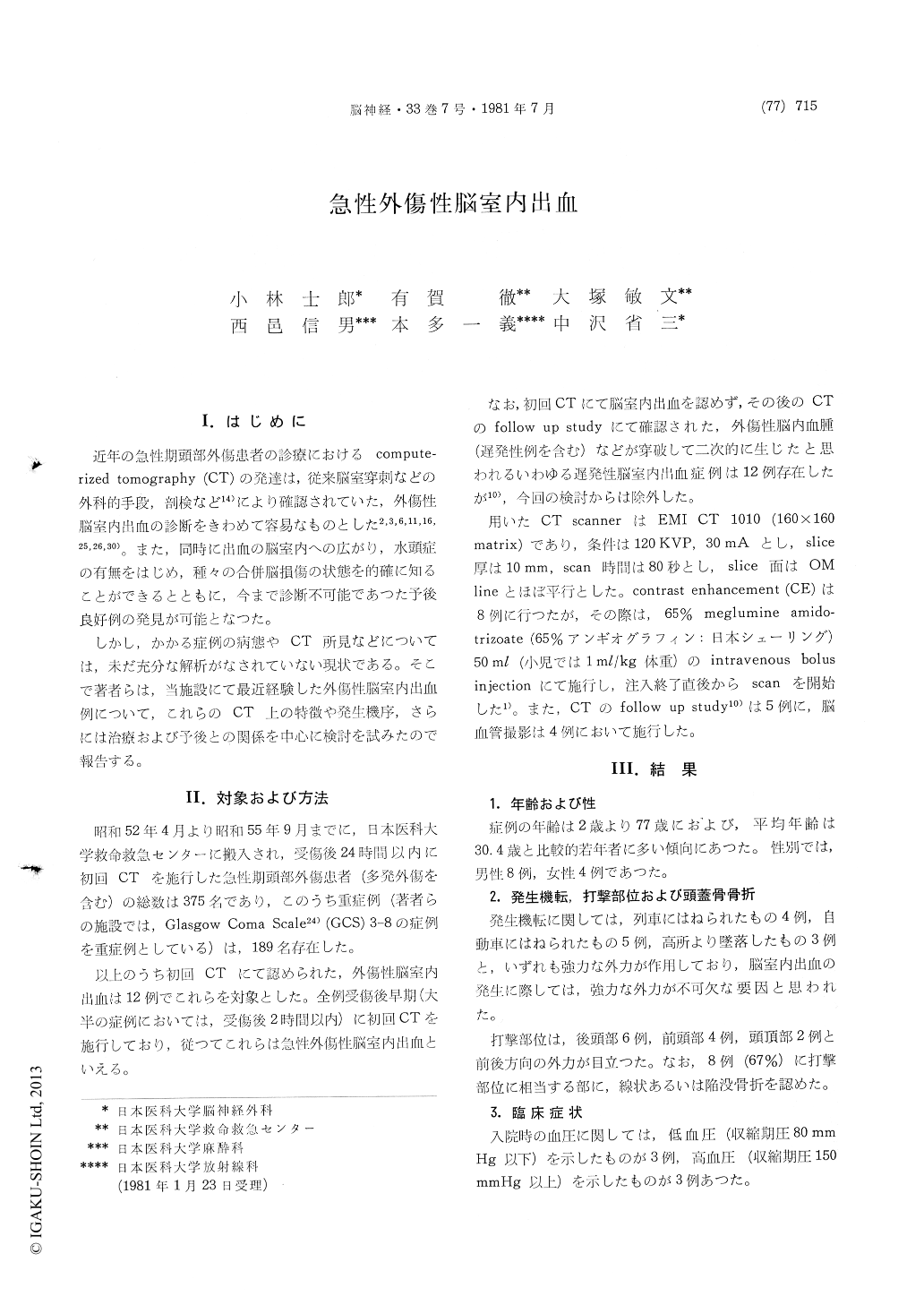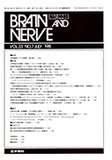Japanese
English
- 有料閲覧
- Abstract 文献概要
- 1ページ目 Look Inside
I.はじめに
近年の急性期頭部外傷患者の診療における compute—rized tomography (CT)の発達は,従来脳室穿刺などの外科的手段,剖検など14)により確認されていた,外傷性脳室内出血の診断をきわめて容易なものとした2,3,6,11,16,25,26,30)。また,同時に出血の脳室内への広がり,水頭症の有無をはじめ,種々の合併脳損傷の状態を的確に知ることができるとともに,今まで診断不可能であつた予後良好例の発見が可能となつた。
しかし,かかる症例の病態やCT所見などについては,未だ充分な解析がなされていない現状である。そこで著者らは,当施設にて最近経験した外傷性脳室内出血例について,これらのCT上の特徴や発生機序,さらには治療および予後との関係を中心に検討を試みたので報告する。
Traumatic intraventricular hemorrhage (TIVH) was difficult or impossible to diagnose before the advent of computerized tomography (CT). They were sometimes revealed by surgery or autopsy. However, the widespread use of CT in the diagnosis and management of patients with acute head injury has given facility in diagnosis of TIVH because of its ability to allow visualization of the entire intracranial contents.
But, to our knowledge, there have not been many series dealing with the occurrence of TIVH in blunt head trauma.
The purpose of this study is to describe CT findings, treatment and prognosis of TIVH.
During the three and a half-year period from April, 1977 through September, 1980, 375 patients (189 patients with severe head injuries; 8 or less by Glasgow Coma Scale [GCS]) were examined by CT within 24 hours after trauma at the Depart-ment of Critical Care Medicine of Nippon Medical School, Tokyo. Among them the authors en-countered 12 patients who suffered from TIVH disclosed by CT within several hours after thetrauma (the majority was scanned within 2 hours after the injury); they would be called ACUTE TIVH.
These patients ranged in age from 2 to 77 years old with the mean of 30.4 years old. Eight were male and 4 were female.
All studies were accomplished on the EMI CT 1010 scanner with a 160×160 matrix. Besides them, contrast enhancement (CE) (8 cases), serial CT (4 cases), and cerebral angiography (4 cases) were performed.
The natures of head injury were as follows : struck by train (4 cases), struck by automobile (5 cases), and fallen down (3 cases). It was supposed that the severe impact would act on the patients producing acute TIVH.
With regard to the site of cranial impact, 6 were occipital, 4 were frontal, and one was parietal, respectively. There was a preponderance of sagital direction impacts. Skull fractures were found in 8 cases (67%) at the region of cranial impact.
Conscious states on admission were 7 or less by GCS (7; 4 cases, 6; 1 case, 5; 3 cases, 4; 1 case, and 3; 3 cases). Seven cases (58%) of acute TIVH demonstrated"primary brainstem injury"clinically.
They could be classified into two types according to the spread of hemorrhage into the ventricular system disclosed by CT. The cases in which the hemorrhages could be seen in the lateral, third and fourth ventricles were classified into"Total-ventricle"type (8 cases). Those in which the hemorrhages could be seen only in the lateral ven-tricles were classified into"Partial-ventricle"type (4 cases). Conscious states on admission of the former were 6 or less by GCS, and outcome of them was so poor that none of them survived more than 6 days after the trauma. On the other hand, conscious states on admission of the latter were all 7 by GCS and all were able to return home without any significant neurological deficits.
Associated CT findings were observed in 10 out of 12 patients. These were traumatic subarachnoid hemorrhage (6 cases), cerebral contusion (4 cases), pneumocephalus (3 cases), acute subdural hematoma (2 cases), acute ventricular dilatation (2 cases), diffuse cerebral swelling (1 case) and isolated small intracerebral hematoma (1 case). But there was no case who had concomitant intracerebral hemor-rhage suggesting the origin of hemorrhage of acute TIVH.
Four of 8 cases with CE showed abnormal en-hancement such as irregular subependymal enhance-ment along the lateral ventricular wall, probably reflecting injuries to the ependyma or subependymal layer, and enhancement of blood filled ventricles with appearance of increase in ventricular size.
Serial CT was accomplished in 5 cases. In these studies, 4 cases showed delayed hydrocephalus and one case demonstrated subdural effusion in bilateral frontal regions.
Cerebral angiography was carried out in 4 cases. No abnormal findings such as aneurysm, arterioven-ous malformation and hemangioma were revealed.
For treatment of acute TIVH, ventricular drain-ages were performed in 3 out of 8 cases of Total-ventricle type. But these procedures could not produce satisfactory results. None of them survived more than 5 days after trauma. On the other hand, four cases of Partial-ventricle type showed good outcome with conservative treatment instead of ventricular drainage. Only one of them required evacuation of subdural effusion and ventriculo-peritoneal shunt for delayed hydrocephalus.
The authors discussed the mechanisms of acute TIVH. It is commonly known that shering injury may be the most accurate mechanism to produce TIVH. The share strain due to impact of traumaacts on the ventricular walls and does damage to the ependyma and/or subependymal structures (in-cluding subependymal vessels) consequently.
There is also another possible mechanism called "central cavitation"(Unterharnscheidt, 1963). It is explained that the ventricular system will be changed in form and size by forces in the sagital direction, however, the CSF can not follow this transient enlargement of the ventricular bodies so rapidly, so that negative pressure zones arise at the ventricular walls (due to "cavitation theory"), which can result in damage to vessels and brain tissue.
Almost damage to the ependyma and sub-ependymal structures may be caused by these mechanisms such as shering injury and"central cavitation". On the other hand, there is a kind of oozing hemorrhage into the ventricular system which comes from vaso-paralysis produced by cer-tain mechanism.

Copyright © 1981, Igaku-Shoin Ltd. All rights reserved.


